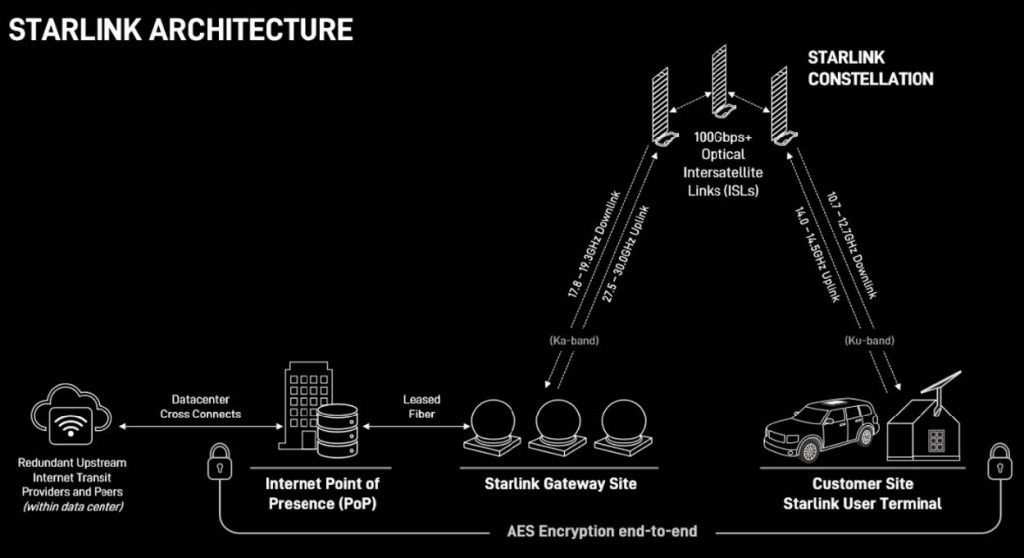At Clarus Networks, we’re proud to be an authorised Starlink reseller, bringing cutting-edge internet connectivity to our customers. We’re excited to share recent advancements made by Starlink engineering teams focused on enhancing network performance, specifically aiming to achieve a stable 20 milliseconds (ms) median latency with minimal packet loss. This commitment to innovation has led to significant improvements in both median and worst-case latency for users globally.
A Leap Forward in Connectivity
Over the past month, remarkable strides have been made to reduce latency across the board. In the United States, median latency during peak usage hours has seen a reduction of more than 30%, dropping from 48.5ms to 33ms. Moreover, the worst-case peak hour latency (p99) has plummeted by over 60%, from upwards of 150ms to less than 65ms. Similar improvements have been observed outside the United States, with median latency reductions of up to 25% and worst-case latencies by up to 35%.
Understanding Latency
Latency, or the round-trip time it takes for a packet to travel from your Starlink router to the internet and back, is crucial for a smooth online experience. It affects everything from how quickly web pages load to the responsiveness of online gaming. Starlink’s engineers continuously monitor and refine the network, focusing on peak usage periods to ensure optimal performance when it matters most.
Factors Influencing Latency
Several key factors drive latency in the Starlink network:
- Speed-of-light propagation: The physical distance data must travel to and from satellites.
- Ground latency: The layout of the ground network and its connection to the internet.
- Fronthaul scheduling: The management of network traffic between satellites and users.
- System efficiencies: Reducing unnecessary processing delays and optimizing network components.
In 2024, the addition of 6 new Points of Presence (PoPs) in the US and other optimizations are set to further reduce latency by ensuring data travels via the shortest possible route.

The Drive for Improvement
Starlink’s commitment to reducing latency is evident in the extensive testing and refinement of their systems. With 193 different satellite software builds, 75 gateway software builds, 222 Starlink software builds, and 57 WiFi software builds deployed since the beginning of the year, the focus on enhancing every aspect of the network is clear.
The Importance of Low Latency for Our Customers
Low latency is not just a number—it’s a critical factor that impacts the efficiency, reliability, and satisfaction of our customers in numerous ways:
Smoother Real-Time Communication
For our customers, low latency means more than just faster internet. It’s about achieving seamless real-time communication, whether it’s for video conferencing, VoIP calls, or live streaming. In today’s digital age, where remote work and virtual meetings are the norms, low latency ensures that these interactions are as smooth and interruption-free as possible, mirroring face-to-face conversations.
Efficient Cloud Service Usage
As businesses and individuals increasingly rely on cloud services for storage, computing, and applications, low latency is crucial. It ensures quick access to data and applications stored in the cloud, enhancing productivity and user experience. For businesses, this means more efficient operations and for individuals, a smoother, frustration-free online experience.
Reliability and Speed of Online Transactions
For customers engaging in online transactions, from shopping to trading, low latency is vital. It ensures that transactions are processed swiftly and reliably, minimizing the risk of timeouts or delays. This reliability is crucial for maintaining trust in online services and platforms.
Enhanced Customer Experience
The cumulative effect of low latency is a significantly enhanced online experience. Faster load times, immediate responsiveness, and uninterrupted streaming contribute to higher satisfaction and loyalty among our customers. In a competitive digital landscape, the quality of online experience is a key differentiator.
Competitive Advantage in Service Delivery
For businesses, low latency isn’t just about improving operations—it’s about gaining a competitive edge. By delivering faster and more reliable services, businesses can stand out in their market, attracting and retaining customers who value efficiency and quality.
Timely Data Analytics and IoT Operations
In the realm of data analytics and the Internet of Things (IoT), low latency is crucial for the timely processing and transmission of data. For industries relying on real-time analytics and IoT devices, this can mean the difference between proactive decision-making and missed opportunities.
Looking Ahead: A Future of Unmatched Connectivity
Starlink’s commitment to continuous improvement through software enhancements and infrastructure development promises even lower latency in the future. With over 2.6 million customers and counting, the journey towards a median latency of 20ms is well underway, and we are excited to be part of this transformative period in internet history.
As we move forward, Clarus Networks remains dedicated to bringing these technological advancements to our customers, ensuring you have access to the fastest, most reliable internet service available. We encourage you to stay updated with the latest performance statistics and developments by visiting our website and starlink.com/map.
In partnership with Starlink, Clarus Networks is not just offering a service; we are creating a new standard for online connectivity, where speed, reliability, and customer satisfaction are paramount. Join us as we explore the possibilities of this new digital frontier, where every connection brings the world closer together.


